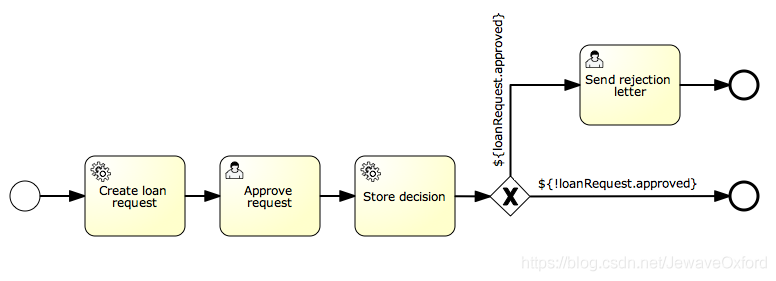工作流持久化详解!Activiti 框架中 JPA 的使用分析

Activiti 中 JPA 简介
可以使用 JPA 实体作为流程变量, 并进行操作:
基于流程变量更新已有的 JPA 实体,可以在用户任务的表单中填写或者由服务任务生成
重用已有的领域模型,不需要编写显示的服务获取实体或者更新实体的值
根据已有实体的属性做出判断(网关即分支聚合)
JPA 实体要求
Activiti 中 JPA 只支持符合以下要求的实体:
实体应该使用 JPA 注解进行配置, 支持字段和属性访问两种方式.@MappedSuperclass 也要能够被使用
实体中应该有一个使用 @Id 注解的主键,不支持复合主键 @EmbeddedId 和 @IdClass:
Id 字段或者属性能够使用 JPA 规范支持的任意类型:
原生态数据类型和他们的包装类型(Boolean 除外)
String
BigInteger
BigDecimal
java.util.Date
java.sql.Date
JPA 配置
引擎必须有一个对 EntityManagerFactory 的引用才能够使用 JPA 的实体,这样可以通过配置引用或者提供一个持久化单元名称
作为变量的 JPA 实体将会被自动检测并进行相应的处理
使用 jpaPersistenceUnitName 配置:
配置一个自定义的 EntityManagerFactory,
这里使用了 OpenJPA 实体管理器
该代码片段仅仅包含与例子相关的 beans,去掉了其他 beans.
OpenJPA 实体管理的完整并可以使用的例子可以在 activiti-spring-examples(/activiti-spring/src/test/java/org/activiti/spring/test/jpa/JPASpringTest.java) 中找到
也可以在编程式创建一个引擎时完成配置:
配置的属性有:
jpaPersistenceUnitName: 使用持久化单元的名称:
要确保该持久化单元在类路径下是可用的,默认的路径是 /META-INF/persistence.xml
要么使用 jpaEntityManagerFactory 要么或者是 jpaPersistenceUnitName
jpaEntityManagerFactory: 一个实现了 javax.persistence.EntityManagerFactory 的 bean 的引用:
将被用来加载实体并且刷新更新
要么使用 jpaEntityManagerFactory 要么或者是 jpaPersistenceUnitName
jpaHandleTransaction: 在被使用的 EntityManager 实例上,该标记表示流程引擎是否需要开始和提交或者回滚事务:
当使用 Java 事务 API(JTA) 时,设置为 false
jpaCloseEntityManager: 该标记表示流程引擎是否应该关闭从 EntityManagerFactory 获取的 EntityManager 的实例:
当 EntityManager 是由容器管理的时候需要设置为 false: 当使用并不是单一事务作用域的扩展持久化上下文的时候
JPA 用法
简单示例
首先,需要创建一个基于 META-INF/persistence.xml 的 EntityManagerFactory 作为持久化单元:包含持久化单元中所有的类和一些供应商特定的配置
使用一个简单的实体作为测试,其中包含有一个 id 和 String 类型的 value 属性,也将会被持久化
在测试之前,创建一个实体并且保存:
启动一个新的流程实例,添加一个实体作为变量. 其他的变量,将会被存储在流程引擎的持久化数据库中.下一次获取该变量的时候,将会根据该类和存储 Id 从 EntityManager 中加载:
流程定义中的第一个节点是一个服务任务,将会调用 entityToUpdate 上的 setValue 方法,其实就是之前在启动流程实例时候设置的 JPA 变量并且将会从当前流程引擎的上下文关联的 EntityManager 中加载:
当完成服务任务时,流程实例将会停留在流程定义中定义的用户任务环节上:
可以查看该流程实例
EntityManager 已经被刷新了并且改变的实体已经被保存进数据库中
获取 entityToUpdate 的变量 value 时,该实体将会被再次加载并且获取该实体属性的值将会是 updatedValue
查询 JPA 流程变量
以查询某一 JPA 实体作为变量的 ProcessInstances 和 Executions
在 ProcessInstanceQuery 和 ExecutionQuery 查询中仅仅 variableValueEquals(name, entity) 支持 JPA 实体变量:
[variableValueNotEquals],[variableValueGreaterThan],[variableValueGreaterThanOrEqual],[variableValueLessThan],[variableValueLessThanOrEqual]不被支持并且传递 JPA 实体值的时候会抛出一个 ActivitiException
使用 Spring beans 和 JPA 结合
JPASpringTest, 在 activiti-spring-examples 中:
已经存在了一个使用 JPA 实体的 Spring-bean, 用来存储贷款申请
使用 Activiti,可以通过已经存在的 bean 获取已经使用的实体,并使用它作为变量用于流程中
流程定义步骤:
服务任务:
创建一个新的贷款申请,使用已经存在的 LoanRequestBean 接受启动流程时候的变量(来自流程启动时候的表单)
使用 activiti:resultVariable(作为一个变量对表达式返回的结果进行存储)将创建出来的实体作为变量进行存储
用户任务:
允许经理查看贷款申请,并填入审批意见(同意/不同意)
审批意见将作为一个 boolean 变量 approvedByManager 进行存储
服务任务:
更新贷款申请实体,因此该实体与流程保持同步
根据贷款申请实体变量 approved 的值,将利用唯一网关自动决定下一步该选择那一条路径:
当申请批准,流程结束
否则,一个额外的任务将会使用(发送拒绝信),这样就可以发送拒绝信手动通知客户

上面的例子展示了 JPA 结合 Spring 和参数化方法表达式的强大优势 :所有的流程就不需要自定义 java 代码(Spring bean 除外),大幅度的加快了流程部署
版权声明: 本文为 InfoQ 作者【攻城狮Chova】的原创文章。
原文链接:【http://xie.infoq.cn/article/9cf21656e2d196d21db910a63】。文章转载请联系作者。












评论